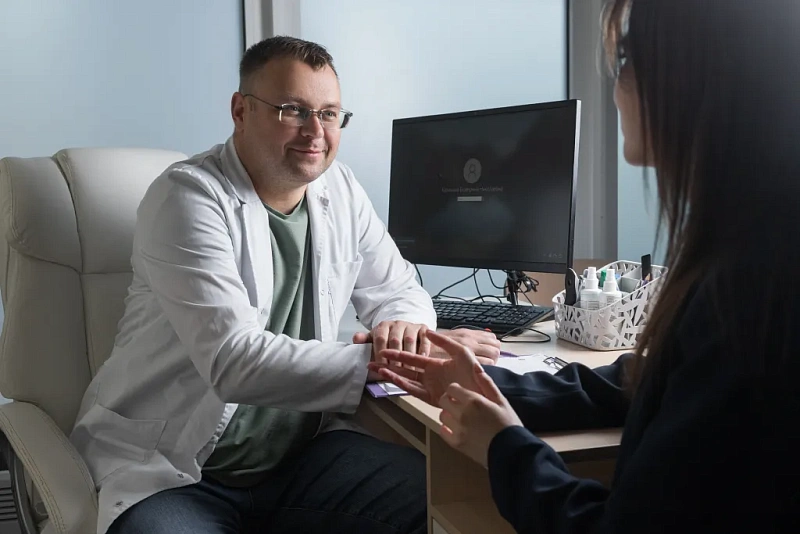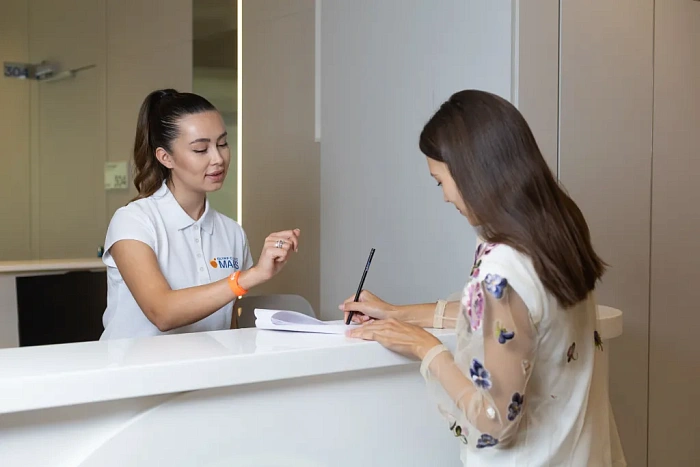Hemorrhoid diagnostics and treatment
Effective solution to hemorrhoids: from nonsurgical treatment to minimally invasive and surgical procedures.

Hemorrhoids are varicose veins in the lower rectum. They cause pain, discomfort, itching, and bleeding. It is one of the most common diseases of the rectum.
The main cause of hemorrhoids is blood that doesn't flow well in the veins of the rectum. This can be caused by sitting or standing for a long time, constipation, heavy lifting, obesity, or a family history of the condition. There are different ways to treat hemorrhoids. Some methods don't require surgery. These include medications, changes to your diet and lifestyle. Later stages may require less-invasive or surgical procedures.
The diagnostic process starts with a review of the patient's symptoms, their duration, and any possible triggers. Next, there is an anal exam and a digital rectal exam. If necessary, a rectoromanoscopy or colonoscopy is performed to see inside the body and determine the stage of the disease. Additional diagnostic tests, such as blood tests, are used to rule out anemia and other possible complications.
In the early stages, nonsurgical methods are used. These include rectal suppositories and ointments to prevent constipation, medication to strengthen blood vessels, and laxatives if necessary. For more severe cases, there are minimally invasive techniques such as ligation with latex rings, sclerotherapy, and infrared photocoagulation. In cases of complications, surgery is needed to remove the swollen veins (hemorrhoidectomy).
After minimally invasive procedures, the patient can go home in just a few hours. In case of surgical intervention, hospitalization usually lasts 1-3 days. Full recovery takes 4-8 weeks.
Benefits
Complications prevention
Early treatment helps avoid thrombosis, anemia and other complications.
Safety
Advanced minimally invasive procedures minimize the risk of complications.
Improving the quality of life
Timely treatment eliminates pain, bleeding and discomfort.
Broad treatment selection
A suitable method is chosen depending on the stage and characteristics of the disease.
Diagnostics
Diagnosis begins with a conversation with the patient, during which the doctor clarifies the symptoms, the duration of their manifestation and possible provoking factors. Then the anal area is examined and a finger examination is performed. Instrumental methods, such as rectoromanoscopy or colonoscopy, allow you to visualize internal nodes and clarify the stage of the disease. Additional studies, such as blood tests, help rule out anemia and other possible complications.

Treatment
At the initial stages, conservative methods are used, including: the use of rectal suppositories and ointments, a fiber-rich diet to prevent constipation, venotonics to strengthen the walls of blood vessels, as well as laxatives if necessary. In more severe forms of the disease, minimally invasive techniques such as latex ring ligation, sclerotherapy, and infrared photocoagulation can be used. If there are complications, surgical removal of the nodes (hemorrhoidectomy) is performed.

Recovery
After minimally invasive procedures, the patient can return home in a few hours. In the case of surgery, hospitalization usually lasts 1-3 days. Full recovery takes 4-8 weeks.

Specialists
Find a SpecialistA coloproctologist, a surgeon.
Similar referral activities
Crohn's disease diagnostics and treatment
Eliminating inflammation, preventing complications, and ensuring long-term remission in Crohn's disease.
Nonspecific ulcerative colitis diagnostics and treatment (NUC)
A comprehensive approach to NUC diagnostics and treatment to control inflammation and achieve remission.
Coloproctologist consultation
Appointment with a coloproctologist to diagnose, treat and prevent diseases of the rectum, anal canal and colon.
How to reach
How to get
From the Belorusskaya metro station of the Zamoskvoretskaya line - exit 4 After exiting the subway, walk through the pedestrian tunnel and climb the stairs. Move towards the railway tracks, go down the stairs immediately after them and walk along the house, then turn right onto 1st Yamskoye Pole Street. At the turn to 3rd Yamsky Pole Street, cross the road at the pedestrian crossing and continue along 1st Yamsky Field Street, after a few buildings on the left you will see Olympus Clinic MARS.
Travel time
9 minutes
Landmark
Olympus Clinic MARS sign
How to get
From the Belorusskaya metro station of the Ring line - exit 2. After exiting the subway, turn left and walk to the pedestrian crossing. Cross the road through two pedestrian crossings and move along the Tverskoy overpass. Go down the stairs immediately after the railway tracks, walk along the house, then turn right onto 1st Yamskoye Pole Street. At the turn to 3rd Yamsky Pole Street, cross the road at the pedestrian crossing and continue along 1st Yamsky Field Street, after a few buildings on the left you will see Olympus Clinic MARS
Travel time
11 minutes
Landmark
Olympus Clinic MARS sign
From the metro station "Tsvetnoy Bulvar"
1 exit to the city, then left to the Garden Ring, at the crossing to the right, crossing the boulevard, one more crossing and at the traffic light to the left. The Olymp Clinic building is located overlooking the Garden Ring to the right of the crossing. Travel time is approximately 9 minutes. Landmark - sign Olymp Clini
From the metro station "Sukharevskaya"
Exit 3 from the metro and 640 meters straight ahead, the clinic will be on the right. Landmark - sign Olymp Clinic
Parking lot map
Exit 3 from the metro and 640 meters straight ahead, the clinic will be on the right. Landmark - sign Olymp Clinic

From Sokol metro station
The last car from the center: follow the signs for Exit 5. From the glass doors to the right and go to the end of the passage. Exit to the city by the steps to the left. After exiting the crossing to the street, go straight along Leningradsky Prospekt to the intersection with Chapaevsky Lane. Next, turn right (onto Chapaevsky Lane) and walk to the Triumph Palace residential complex. Entrance to the territory: through checkpoint No. 1, opposite the Vkusville store, you will need to present your passport. After passing through the checkpoint, go up the stairs to the fountain, opposite it you will see our clinic.
Travel time
10-12 minutes
From the Airport metro station
The first car from the center: follow the Exit 2-3 signs. Turn left out of the glass doors and walk to the end of the passage. After exiting the crossing to the street, go straight along Leningradsky Prospekt to the intersection with Chapaevsky Lane. Next, turn left (onto Chapaevsky Lane) and walk to the Triumph Palace residential complex. Entrance to the territory: through checkpoint No. 1, opposite the Vkusville store, you will need to present your passport. After passing through the checkpoint, go up the stairs to the fountain, opposite it you will see our clinic.
Travel time
12-15 minutes
How to get
Entry to the territory is prohibited, but there are free city parking lots around the Triumph Palace residential complex, where you can easily find a place for your car. Free parking area:




